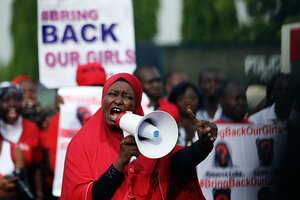Boko Haram's kidnapped girls: Nigeria's side of the story
The Chibok girls were abducted in a state the size of Ireland that has 30,000 schools. Those basic logistics are not so easy to surmount.

A protester addresses the 'Bring Back Our Girls' protest group as they march to the presidential villa to deliver a protest letter to Nigeria's President Goodluck Jonathan in Abuja, calling for the release of the Nigerian schoolgirls in Chibok who were kidnapped by Islamist militant group Boko Haram, May 22, 2014.
Afolabi Sotunde/Reuters/File
A version of this post originally appeared on Africa in Transition. The views expressed are the author's own.
Nigerian president Goodluck Jonathan and his administration have been subject to withering criticism at home and abroad over the government’s response to the Boko Haram kidnapping of some three hundred schoolgirls from Chibok.
There are ongoing demonstrations in Nigeria by women, united across ethnic and religious boundaries, calling for greater government engagement in finding and liberating them.
Abroad, the episode has highlighted Nigeria’s governance challenges, including corruption and the apparent near-collapse of its military.
Amb. Olusegun Akinsanya, office director of the Institute for Security Studies in Addis Ababa, a former senior Nigerian diplomat, a businessman, and an academic, has written a thoughtful analysis of the Chibok kidnapping and why it has been so hard for the Nigerian government to overcome Boko Haram.
Though titled “The Chibok Girls—Nigeria’s Side of the Story,” the piece is not a whitewash of the government’s “slow and inadequate” response to the crisis.
But he does highlight some of the practical difficulties the government faces. He points out that Borno state is about the size of Ireland. There are over 30,000 schools in the state. The infrastructure is woefully underdeveloped. These factors limit, he suggests, what the army and government can do.
Amb. Akinsanya maintains that, in fact, the government has done much to recover the girls, but it has failed to adequately communicate its actions to the public.
He also looks at the deeper causes of Boko Haram: economic underdevelopment in the north, youth unemployment, climate change (including the drying-up of Lake Chad).
He notes the impact of the upcoming February 2015 national elections as well. Without developing the theme, he suggests that those elections “could serve to appease the political situation,” which seems counterintuitive given the bloodshed following the elections of 2011.
In his analysis of Boko Haram, I would have liked to see a discussion of the end of power alternation between north and south, the role of corruption, and his thoughts on the causes of the military’s collapse. He observed that “orthodox Muslims” do not approve of Boko Haram’s methods. Very true. But much of the traditional Islamic leadership in the north appears to be discredited on the “street.”
Perhaps in subsequent articles Amb. Akinsanya will be able to address some of these issues.

